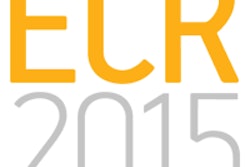
BRUSSELS - A senior German molecular imaging specialist has appealed to national health institutes across Europe to do more to encourage clinical and basic scientists to communicate better, claiming there is excellent basic research but a lack of translation, and translational research must "cross the Valley of Death."
 Tumor treatments can be dramatically improved with peptide receptor radionuclide therapy, Dr. Richard Baum told attendees at the AIPES meeting. All photos courtesy of Alohafred Photography, Brussels, www.alohafred.com.
Tumor treatments can be dramatically improved with peptide receptor radionuclide therapy, Dr. Richard Baum told attendees at the AIPES meeting. All photos courtesy of Alohafred Photography, Brussels, www.alohafred.com.Speaking at last week's molecular imaging event organized by the Association of Imaging Producers & Equipment Suppliers (AIPES), Dr. Richard Baum, chairman and clinical director of the Department of Nuclear Medicine and Center for PET/CT at Zentralklinik Bad Berka, outlined some of the major changes taking place in oncologic imaging.
He suggested that peptide receptor radionuclide therapy (PRRT) offered one of the best examples of the much-heralded personalized medicine, where a precise, targeted treatment is given for the individual patient at a particular time.
"Targeted radionuclide therapy has unique promise for personalized treatment of cancer, because both the targeting vehicle and the radionuclide can be tailored to the individual patient," he said. "The future of cancer treatment will not be on talking about where it is localized, but on the molecular pathology and by the molecular imaging studies."
Tumor treatments could be dramatically improved with PRRT, the molecular targeted therapy that uses small peptides coupled with radionuclide emitting beta radiation, according to Baum.
"We can break the cycle of trial and error medicine," he said. "Targeted radionuclide medicine has a unique promise for this."
 To underline the promise of targeted radionuclide therapy, Baum showed this witty slide at the end of his talk.
To underline the promise of targeted radionuclide therapy, Baum showed this witty slide at the end of his talk.Baum explained that PRRT has been used to treat more than 1,200 patients with metastasized neuroendocrine tumors, mostly in the pancreas. He said one of his PRRT success stories was a 17-year-old patient, who first came to the clinic in 1997 as a paraplegic, but following treatment, he could walk by 2002 and could play soccer a year later.
 Situated in Leopold Park in the heart of the European Quarter, the Solvay Library was the venue for the AIPES meeting, "Paving the way to the best sustainable molecular healthcare model in Europe."
Situated in Leopold Park in the heart of the European Quarter, the Solvay Library was the venue for the AIPES meeting, "Paving the way to the best sustainable molecular healthcare model in Europe.""PRRT promises several years of longer survival and progression than other treatments like chemotherapy, somatostatin analogues, and molecular therapies," he said, adding that research so far revealed far fewer side effects than rival treatments.
The Zentralklinik Bad Berka is one of just four European centers to have administered PRRT since the mid-1990s, the others being in Basel (Switzerland), Milan (Italy), and Rotterdam (the Netherlands). He underlined that as well as being clinically and economically effective, PRRT was also remarkably precise.
"We can now detect very small lesions, as well as primary tumors," Baum said, adding that this line of nuclear medicine offers "not just weeks and months, but years to lives."
He backed the potential of treatments using gallium-68-labeled tracers, pointing out that gallium chemistry was well studied, and it was relatively easy to build and operate generators to purify and synthesize the peptides. He noted that gallium's ability to quantify disease at a molecular level was clearly superior to single gamma-emitting radionuclides and SPECT. Furthermore, there are many new, possible avenues to improve PRRT in the future, including DUO-PRRT, TANDEM-PRRT, and combined PRRT.
Baum also spoke about the principles of theranostics, the term used to describe a diagnostic tool that helps define the right therapeutic tool for a specific disease, and epitomizes the inseparability of diagnosis and therapy.



















